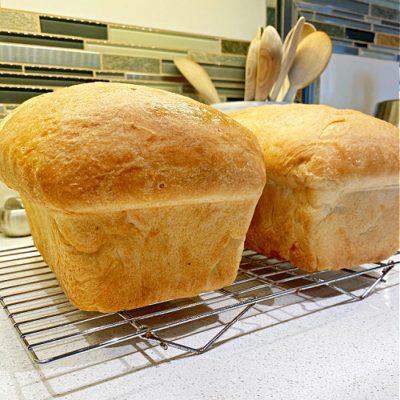
Everyday Sandwich Bread
This bread is versatile and great for sandwiches, toast, and grilled cheese.
Equipment
- stand mixer, with dough hook attachment
- 2 loaf pans or 1 long loaf pan, greased
Ingredients
- 4 tsp instant yeast
- 1 cup warm water (~90° to 95° F)
- ¼ cup molasses or honey (molasses will give the bread a deeper color)
- 3 tbsp butter, melted (I use salted butter because that's what I always have on hand)
- 3 to 4 cups warm water (~90° to 95° F)
- 6 cups all-purpose flour (bread flour also works)
- 2 cups whole wheat flour (this is the wild-card flour*)
- 1 tbsp kosher salt
Instructions
Hydrate the yeast
- In the bowl of a stand mixer with the bread hook attachment, add 4 teaspoons of instant yeast and 1 cup of warm water (90 to 95 degrees). Whisk together. Let stand for about 5 minutes until the yeast mixture has a yeasty head.
Melt the butter
- Melt the butter in the microwave or on the stove. Set aside to cool.
Feed the yeast
- Add molasses (or honey) to yeast mixture.
Mix the dry ingredients
- In a large mixing bowl, whisk together the dry ingredients (the two flours and salt).
Make the dough
- In the stand mixer, and 2 cups of the dry ingredients. Mix together on low speed. Add the butter. You can use the paddle attachment for this step, but switch to the bread for the next step.
- Once the 2 cups of dry ingredients are mixed together well with the yeast mixture and butter, slowly add the warm water and remaining dry ingredients. Alternating water and dry ingredients. You may not need all the water, depending on the the level of humidity in your kitchen.
- You may need to stop mixing a few time to push the dough down the bowl and make sure all the dry ingredients are getting incorporated.
- Once the dry ingredients and necessary amount of water have been added and mixed, the dough can be kneaded in the bowl. The dough should pull away from the sides of the bowl and be a little sticky.
- Knead the dough on medium speed for about 8 minutes. If kneading by hand, turn the dough out onto a lightly floured surface and knead for about 10 minutes. The dough should feel warm to the touch and be soft.
Let the dough rise
- Grease a large mixing bowl (I reuse the dry ingredients bowl) and place bread dough in the bowl. Cover the bowl with a clean kitchen towel and place in a non-drafty area (I sometimes let the dough rise in a cool oven with the oven light on). Let the dough rise until it's doubled in size, between 45 minutes to an hour.
Shape the loaf and let the dough proof
- Grease the bread pan. I like to use butter rather than vegetable oil--the bread slides out of the pan after baking much easier.
- Once the dough has doubled in size, gently punch it down and turn it out onto a clean surface. I don't flour the surface at this stage. Between the butter in the bread and the oil from the greased bowl, the dough shouldn't stick to your surface.
- Press the dough out into a square that's roughly the same width as the bread pan. If you're using two standard-sized loaf pans (4 ½" x 8 ½"), divide the dough and prep two separate loaves.
- Roll up the dough in a pinwheel fashion, making sure to tuck in the ends. (You don't need to be super delicate with the dough. Make sure pinch and seal the seems as much as you can to prevent air pockets.)
- Please shaped dough in greased bread pan. Cover with clean kitchen towel.
- Let proof for about 45 minutes to 1 hour, or until the top of the bread is about an inch above the top of the pan.
- Preheat oven to 400° F.
Bake the bread
- Bake the load (loaves) for about 45 minutes, until the top is golden. Rotate 20 minute through baking. Internal temperature should be 190°F when done.
Rest and cool
- Let the bread cool in the pan for 10 minutes
- Turn out bread onto cooling rack and let cool completely before slicing.
Notes
If you're using a long loaf pan, I recommend cutting the loaf in half after it completely cools to make slicing more manageable. We store the loaves in old plastic bread bags from store-bought hotdog buns and pita rounds. Otherwise, a zip-loc bag works well. Cloth bread bags are ok, but I recommend wrapping the bread in cling wrap to prevent it from drying out.
The key to a good loaf with no air pockets is shaping the dough tightly, making sure to seal overlap and seams. I sometime pat the dough after shaping it.
* The wild-card flour means that you can substitute other flours for the whole wheat flour or use all all-purpose or bread flour. I really like 85 malted flour or rye, but seriously, I've tried everything from spelt to pumpernickel and the bread always turns out great. For darker flours I prefer using molasses instead of honey for a deeper flavor.